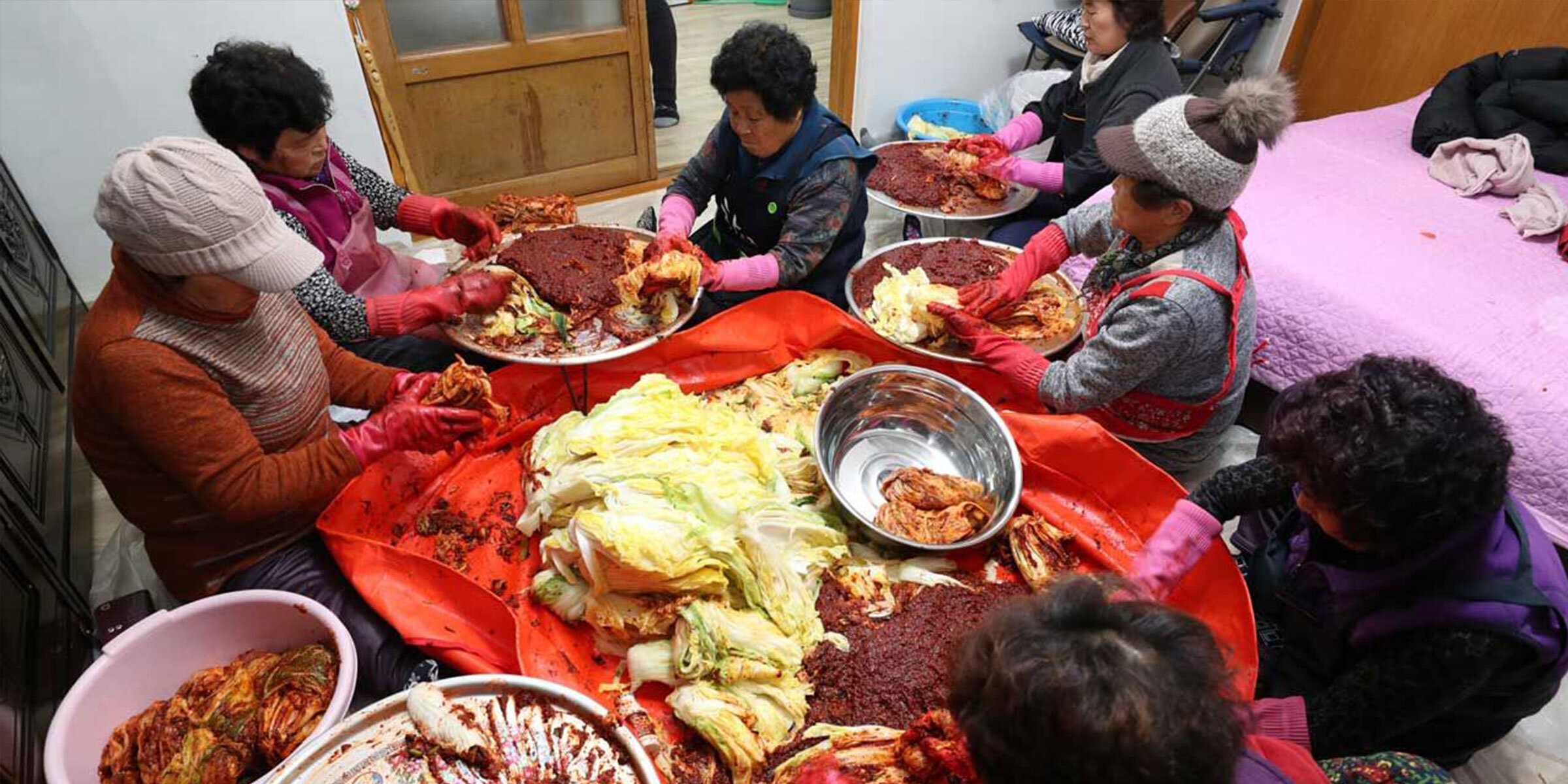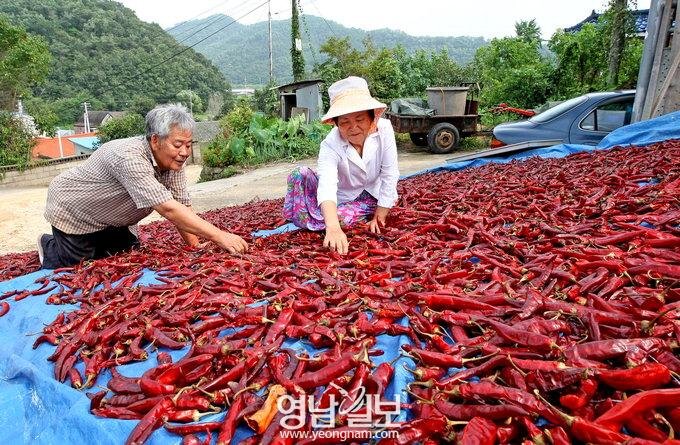Kimjang: The Art of Kimchi Making
October has begun, signaling the passing of summer and welcoming the season of fall foliage. Around mid-autumn to winter time, Korean households bustle with people in the nearly-ritualistic ceremony of kimchi (김치) making, or what Koreans call it, kimjang (김장). As a recognized intangible Cultural Heritage of Humanity by UNESCO (2013), kimjang is a practice of preparing kimchi, which is “preserved vegetables seasoned with spices and fermented seafood” for a year-long preservation.
The main ingredient most commonly seen in kimchi is cabbage (배추김치), but it varies depending on the kind of kimchi. Square-shaped radish kimchi (깍두기) is usually in small, bite-size pieces so it is easy to consume. Ponytail radish kimchi (총각김치) is not cut like the previous radish kimchi and comes with ponytail greens at the end of the radish. There are many other types of kimchi that are enjoyed by Koreans, like water kimchi (물김치), where radish and greens are added in a drinkable broth, or cucumber kimchi, which is made with cucumbers as the main ingredient. Kimchi is a part of Koreans’ everyday meal. In the ritualistic process of kimjang, which lasts through an entire year, there lies a rather paradoxical idea—that kimjang as a communal ceremony emphasizes living life to its fullest with kimchi as a source of surviving, and yet the preparation of it is deeply relevant to time, which ticks towards a complete stop of all things.
Life with Nature, in Nature, and as Nature
In the kimjang process, touches of each of the four seasons are inserted in kimchi through a collection of natural ingredients. The napa cabbage, a natural food itself, is salted before other ingredients are added. Koreans search for ingenious food sources from the soil or ocean and excavate them during different seasons of the year. Thus, the finished kimchi at the end of the year can possess all the aspects of spring, summer, autumn, and winter. Within this one simple-looking side dish contains bits from all of Korea’s mountains, plains, and seas. The output is a combination of changed landscapes and natural atmospheres of each season.
Spring is a season of new gain, a start, and it is where new lives come to be part of the world, from the mountains, the plains, and the sea. In this season, housewives climb the hills and mountains to start preparing for the rest of the year. They dig up various namul (나물) or plant vegetables such as minari (미나리) that will be enough to feed all their families through the year. They “procure shrimp, anchovy, and other seafood” to be salted and fermented, which will be used as seasoning for kimchi. The collected seafood and namul will be added to level up the entire flavor of kimchi with the abundant taste of nature.
Image: Yeongnam
Showering with nutrition and energy, summer is the season of growth. The brined napa cabbage is spiced up with grounded, sun-dried chili peppers. Not only do the peppers color the cabbage in bright red, but it makes kimchi one of the most beneficial foods for health. According to one study, people who consumed spicy food six to seven times a week showed “14 percent relative risk reduction in total mortality” compared to those who only consumed spicy foods once a week. Summer ingredients give the strength to mature and move forward with the rest of the process to come.
Mid-autumn and winter are time to prepare for the end of the year. People share the moment to enter the process of deterioration. The day of kimjang is chosen after a close monitoring of the “weather forecasts to determine the most favorable [sic] date and temperature.” The ingredients already collected in the previous months are brought together. Families, friends, and neighbors gather and squat down on the ground in the cold to coat each sheet of cabbage bouquet with paste made with mixed ingredients. Then the kimchi goes into hibernation, preserved away for a year or sometimes longer before it can be enjoyed—until it is well fermented and fresh.
It is an odd concept that kimchi is only delicious when it is well pickled. It is as though all matters in life are most enjoyable and flavorful only when things are fully matured—becoming less oblivious to the world around them. Perhaps there is an unexpected lesson to be learned from making kimchi, to be at an age or a state clever enough to not be remiss about what could be valuable and precious, and to live without regrets.
A Sense of Community: More Than Achievement of Solidarity
Kimjang is a form of socializing where everyone participates to make large quantities of kimchi that will go around to everyone in the community for a whole year. The process is about achieving solidarity as a community. Perhaps it is a moment when people share small talks about love, concerns, anger, joy, and all the emotions that make up their life. It may be a moment where they feel more alive than ever, energetic and fun, reminding themselves once again that people are social beings. And all the friends, families, and neighbors who joined to make this food hope for a time well spent and moments of no regret. Waiting and letting time pass by is what many Koreans still contemplate since the old times to this day. Kimjang flourishes with Koreans’ spirit and their ideas of aging, living wisely, and to meet the end in peace.
Closing: Timeless Art
Kimchi making is timeless in that it alludes to a concept that can relate to every living person. It celebrates life, rejuvenation, energy, and an effort to live life, but it also deeply commemorates and accepts the nature of time, which only flows to end or dissolve away. It can be said that in a single mere side dish, each maker’s accumulated mentality and spirit creates different tastes. As the words “taste of mother’s hands (엄마의 손 맛)” suggests, kimchi is made with a mother’s love, care, and hope for the children who eat it, making it the most intimate yet special food.
Thus, this is the reason why kimchi still exists to this day as many Koreans’ soul food. While the process emphasizes the transformation of nature, kimjang brings to attention the real value in the unchanged things in life, such as the symbiotic nature of human beings and the fact that life is filled with potential to change itself. Kimjang is such a timeless art. Or perhaps, life and existence are a timeless art in that all people diligently work to craft their lives with meaningful events in hopes that they will continue to inspire others and spread positive influence to the current generation and the next.


